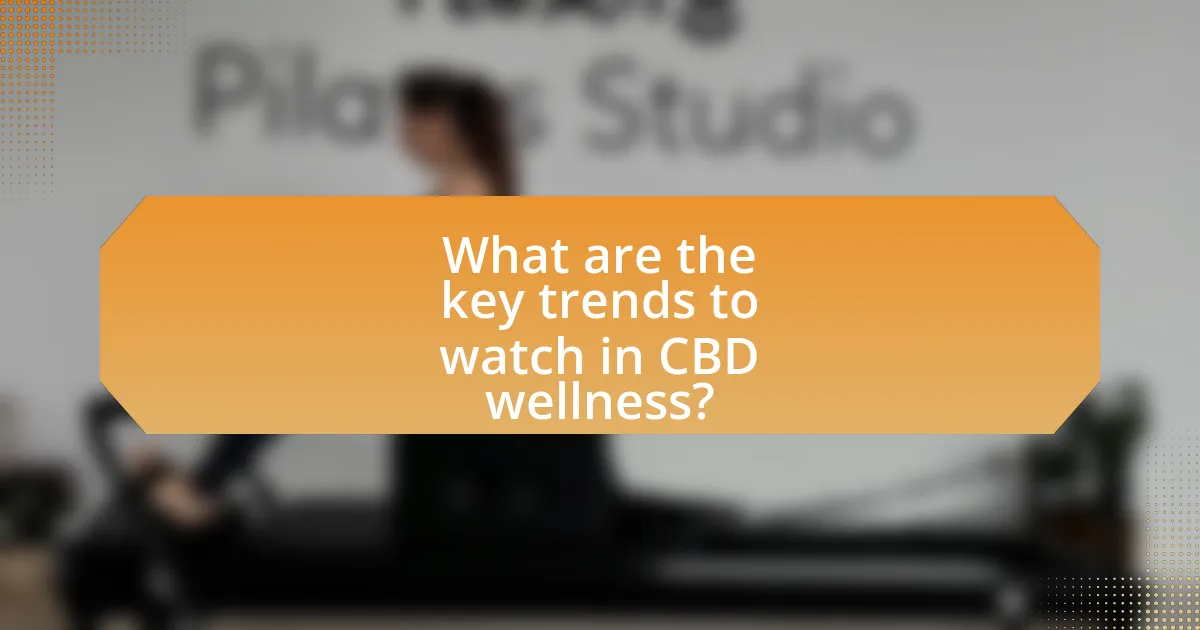The article focuses on the future of CBD in wellness, highlighting its anticipated growth driven by increasing consumer demand for natural health products. It outlines the current applications of CBD, including pain relief, anxiety reduction, and sleep improvement, supported by research validating its therapeutic benefits. Key trends such as personalized products, sustainability, and regulatory developments are discussed, along with the impact of consumer attitudes on market dynamics. The article also addresses challenges faced by the CBD industry, including misconceptions and regulatory hurdles, while emphasizing the importance of education and transparency for consumer safety and informed decision-making.

What is the Future of CBD in Wellness?
The future of CBD in wellness is poised for significant growth, driven by increasing consumer awareness and demand for natural health products. Research indicates that the global CBD market is expected to reach approximately $47 billion by 2028, reflecting a compound annual growth rate (CAGR) of 21.2% from 2021 to 2028. This growth is fueled by expanding applications of CBD in areas such as pain management, anxiety relief, and sleep improvement, supported by ongoing studies that validate its therapeutic benefits. Additionally, regulatory changes and the normalization of CBD products in mainstream wellness sectors are likely to enhance accessibility and consumer trust, further solidifying CBD’s role in holistic health practices.
How is CBD currently used in wellness practices?
CBD is currently used in wellness practices primarily for its potential therapeutic benefits, including pain relief, anxiety reduction, and sleep improvement. Many individuals incorporate CBD into their daily routines through various forms such as oils, capsules, edibles, and topical applications. Research indicates that CBD may interact with the endocannabinoid system, which plays a role in regulating mood, pain, and sleep cycles. A study published in the Journal of Clinical Psychology found that CBD significantly reduced anxiety levels in participants, supporting its use in wellness practices aimed at mental health. Additionally, a survey by the Brightfield Group revealed that 60% of CBD users reported using it for anxiety relief, highlighting its growing acceptance in wellness routines.
What are the most common applications of CBD in wellness?
The most common applications of CBD in wellness include pain relief, anxiety reduction, and sleep improvement. Research indicates that CBD interacts with the endocannabinoid system, which plays a crucial role in regulating pain and mood. A study published in the Journal of Pain Research found that CBD significantly reduced chronic pain in participants, demonstrating its effectiveness as a pain management solution. Additionally, a review in the journal Neurotherapeutics highlighted CBD’s potential to alleviate anxiety symptoms, making it a popular choice for individuals seeking natural anxiety relief. Furthermore, CBD has been shown to improve sleep quality, as noted in a study published in The Permanente Journal, where participants reported better sleep after using CBD. These applications underscore CBD’s growing role in wellness practices.
How does CBD interact with the body’s endocannabinoid system?
CBD interacts with the body’s endocannabinoid system by binding to cannabinoid receptors, primarily CB1 and CB2, which are part of this regulatory system. This interaction helps modulate various physiological processes, including pain sensation, mood, and immune response. Research indicates that CBD does not bind directly to these receptors but influences them indirectly, enhancing the body’s natural endocannabinoids, such as anandamide, which can lead to therapeutic effects. Studies, such as those published in the Journal of Pain Research, demonstrate that CBD can reduce inflammation and pain, supporting its role in wellness applications.
Why is the future of CBD in wellness significant?
The future of CBD in wellness is significant due to its potential to address various health issues and its growing acceptance in mainstream health practices. Research indicates that CBD may help alleviate anxiety, reduce inflammation, and manage chronic pain, making it a valuable alternative or complement to traditional treatments. A study published in the Journal of Pain Research found that CBD significantly reduced pain and improved sleep quality in patients with chronic pain conditions. This evidence supports the increasing integration of CBD into wellness routines, reflecting a shift towards natural and holistic health solutions.
What trends are emerging in the wellness industry regarding CBD?
Emerging trends in the wellness industry regarding CBD include increased consumer demand for transparency in sourcing and formulation, a rise in personalized wellness products, and the integration of CBD into various health and beauty products. Consumers are increasingly seeking products that provide clear information about the origin and quality of CBD, as evidenced by a 2022 survey indicating that 73% of CBD users prioritize product transparency. Additionally, personalized wellness solutions are gaining traction, with companies offering tailored CBD formulations based on individual health needs. The beauty sector is also witnessing a surge in CBD-infused products, with the global CBD skincare market projected to reach $1.7 billion by 2025, reflecting a growing acceptance of CBD as a beneficial ingredient in personal care.
How do consumer attitudes towards CBD influence its future in wellness?
Consumer attitudes towards CBD significantly influence its future in wellness by shaping market demand and product development. Positive perceptions of CBD as a natural remedy for anxiety, pain, and sleep disorders have led to increased consumer interest, driving a projected market growth rate of 21.2% from 2021 to 2028, according to a report by Grand View Research. Additionally, consumer preferences for transparency and quality in CBD products are prompting companies to invest in third-party testing and clear labeling, which further enhances trust and acceptance. As consumers become more educated about CBD’s benefits and potential risks, their attitudes will continue to dictate the evolution of product offerings and regulatory frameworks in the wellness sector.

What are the key trends to watch in CBD wellness?
Key trends to watch in CBD wellness include the rise of personalized CBD products, increased focus on sustainability, and the integration of CBD into mainstream health and wellness routines. Personalized CBD products are gaining traction as consumers seek tailored solutions for specific health issues, supported by research indicating that individualized approaches can enhance efficacy. Sustainability is becoming a priority, with brands adopting eco-friendly practices in sourcing and packaging, reflecting consumer demand for environmentally responsible products. Additionally, the integration of CBD into everyday wellness routines, such as in beverages and skincare, is expanding, driven by a growing acceptance of CBD in the wellness community and a market projected to reach $13.4 billion by 2028, according to a report by Grand View Research.
How is the regulatory landscape evolving for CBD products?
The regulatory landscape for CBD products is evolving towards increased clarity and standardization. Recent legislative efforts, such as the introduction of the Hemp Farming Act and ongoing discussions in Congress regarding the regulation of CBD in food and dietary supplements, indicate a shift towards more defined guidelines. The FDA has also begun to explore regulatory frameworks for CBD, emphasizing safety and efficacy, which reflects a growing recognition of CBD’s potential benefits and the need for consumer protection. This evolution is supported by the increasing demand for CBD products, which reached an estimated market value of $4.6 billion in 2023, prompting regulators to establish comprehensive policies to ensure product quality and safety.
What recent legislation impacts the CBD wellness market?
Recent legislation impacting the CBD wellness market includes the 2018 Farm Bill, which legalized hemp-derived CBD at the federal level in the United States. This legislation allows for the cultivation and sale of hemp and its derivatives, including CBD, provided they contain less than 0.3% THC. The Farm Bill has significantly expanded the CBD market, enabling businesses to operate legally and consumers to access a wider range of CBD products. Additionally, various states have enacted their own regulations regarding the sale and use of CBD, further shaping the market landscape.
How do regulations affect consumer safety and product quality?
Regulations significantly enhance consumer safety and product quality by establishing standards that manufacturers must meet. These regulations, such as those enforced by the Food and Drug Administration (FDA) in the United States, require rigorous testing and labeling of products, ensuring that consumers receive accurate information about the contents and potential effects of CBD products. For instance, the FDA has issued guidelines that mandate the disclosure of ingredients and the prohibition of misleading claims, which helps prevent the sale of substandard or harmful products. This regulatory framework not only protects consumers from unsafe products but also promotes higher quality standards across the industry, fostering trust and accountability among manufacturers.
What innovations are being introduced in CBD wellness products?
Innovations in CBD wellness products include enhanced bioavailability formulations, such as nanoemulsions and liposomal delivery systems, which improve absorption rates in the body. These advancements allow for more effective dosing and quicker onset of effects, addressing consumer demand for faster results. Additionally, the introduction of personalized CBD products, tailored to individual health needs and genetic profiles, is gaining traction, supported by research indicating that personalized medicine can lead to better health outcomes. Furthermore, the integration of CBD with other functional ingredients, like adaptogens and vitamins, is becoming popular, as it enhances the overall wellness benefits and appeals to health-conscious consumers.
What new formulations are being developed for CBD wellness?
New formulations being developed for CBD wellness include water-soluble CBD, nanoemulsions, and CBD-infused beverages. Water-soluble CBD enhances bioavailability, allowing for quicker absorption into the bloodstream, which is supported by studies indicating that nanoemulsified formulations can increase absorption rates by up to 200%. Additionally, CBD-infused beverages are gaining popularity, with market research showing a projected growth rate of 40% in the functional beverage sector, driven by consumer demand for convenient wellness solutions. These innovations reflect a trend towards more effective and accessible CBD products in the wellness industry.
How are technology and research advancing CBD applications?
Technology and research are advancing CBD applications through innovative extraction methods and clinical studies that validate its therapeutic benefits. Advanced extraction techniques, such as supercritical CO2 extraction, enhance the purity and potency of CBD, making it more effective for various health applications. Additionally, research published in journals like the Journal of Pain Research demonstrates that CBD can significantly reduce chronic pain and inflammation, supporting its use in pain management. These advancements not only improve product quality but also provide scientific backing for the efficacy of CBD, fostering greater acceptance and integration into wellness practices.

What challenges does the CBD wellness industry face?
The CBD wellness industry faces significant regulatory challenges that hinder its growth and market acceptance. These challenges stem from the lack of a unified regulatory framework across different regions, leading to inconsistencies in product quality, labeling, and marketing practices. For instance, the U.S. Food and Drug Administration (FDA) has not established clear guidelines for CBD products, creating uncertainty for manufacturers and consumers alike. Additionally, the stigma associated with cannabis products continues to affect public perception and acceptance, limiting market expansion. According to a 2021 survey by the Brightfield Group, 70% of consumers expressed concerns about the safety and efficacy of CBD products, highlighting the need for more robust regulations and consumer education to address these challenges effectively.
How does market saturation affect CBD wellness products?
Market saturation negatively impacts CBD wellness products by increasing competition and driving down prices. As more brands enter the market, consumers face a wider array of choices, which can dilute brand loyalty and make it challenging for individual companies to differentiate their products. According to a report by Grand View Research, the global CBD market is expected to reach $13.4 billion by 2028, indicating significant growth but also highlighting the potential for oversaturation. This saturation can lead to price wars, reducing profit margins for companies and potentially compromising product quality as businesses cut costs to remain competitive.
What strategies can companies use to differentiate their CBD offerings?
Companies can differentiate their CBD offerings by focusing on product quality, unique formulations, and targeted marketing strategies. High-quality sourcing of hemp and rigorous third-party testing can establish trust and credibility among consumers. Unique formulations, such as combining CBD with other beneficial ingredients like adaptogens or essential oils, can cater to specific wellness needs, enhancing product appeal. Additionally, targeted marketing strategies that emphasize the benefits of CBD for particular demographics or health concerns can create a distinct brand identity. For instance, a study by the Brightfield Group indicates that brands focusing on specific consumer segments, such as athletes or seniors, can capture niche markets effectively.
How do consumer misconceptions impact the CBD wellness market?
Consumer misconceptions significantly hinder the growth of the CBD wellness market by creating distrust and confusion among potential buyers. Misunderstandings about the legality, safety, and efficacy of CBD products lead to hesitance in purchasing, as many consumers mistakenly associate CBD with psychoactive effects similar to THC. According to a survey by the Brightfield Group, 70% of consumers are unaware that CBD is non-psychoactive, which directly affects their willingness to try these products. Additionally, misconceptions about the regulatory status of CBD can deter consumers, as they may believe that all CBD products are illegal or unregulated. This lack of clarity can result in reduced market penetration and slower adoption rates, ultimately stunting the potential for growth in the CBD wellness sector.
What role does education play in the future of CBD in wellness?
Education plays a crucial role in the future of CBD in wellness by informing consumers and healthcare professionals about its benefits, risks, and proper usage. As the CBD market expands, comprehensive education can help demystify the compound, enabling individuals to make informed decisions based on scientific evidence. For instance, a study published in the Journal of Cannabis Research highlights that increased awareness and understanding of CBD’s therapeutic potential can lead to better health outcomes and reduced stigma surrounding its use. Furthermore, educational initiatives can guide regulatory practices, ensuring that products are safe and effective, ultimately fostering trust in CBD as a legitimate wellness option.
How can consumers be better informed about CBD products?
Consumers can be better informed about CBD products through comprehensive labeling, educational resources, and third-party testing. Comprehensive labeling ensures that consumers understand the product’s ingredients, dosage, and potential effects, which is crucial given that the CBD market lacks uniform regulations. Educational resources, such as articles, webinars, and workshops, can provide insights into the benefits and risks associated with CBD use. Third-party testing offers transparency by verifying the product’s cannabinoid content and purity, helping consumers make informed choices. According to a study published in the Journal of Cannabis Research, consumers who have access to detailed product information and educational materials are more likely to use CBD safely and effectively.
What resources are available for learning about CBD in wellness?
Resources for learning about CBD in wellness include scientific journals, online courses, and reputable websites. Scientific journals such as the Journal of Cannabis Research provide peer-reviewed studies on the effects of CBD on health and wellness. Online platforms like Coursera and Udemy offer courses that cover the basics of CBD, its benefits, and its applications in wellness. Additionally, websites like Project CBD and the National Center for Complementary and Integrative Health provide evidence-based information and research findings on CBD’s role in wellness. These resources collectively enhance understanding and knowledge about CBD’s potential benefits and applications in health.
What practical tips can consumers follow when choosing CBD wellness products?
Consumers should prioritize third-party lab testing when choosing CBD wellness products to ensure quality and safety. Third-party lab testing verifies the product’s cannabinoid content and checks for contaminants, providing transparency and reliability. According to a study published in the Journal of the American Medical Association, many CBD products do not contain the amount of CBD claimed on the label, highlighting the importance of lab results. Additionally, consumers should look for products derived from hemp grown in the U.S., as these are subject to stricter regulations. Checking for clear labeling, including dosage information and ingredient lists, further aids in making informed choices.



